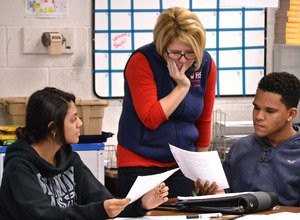Originally posted at my EdWeek Teacher blog, Capturing the Spark (5/26/16).
My Facebook and Twitter feeds are starting to show signs of summer – the pressure of final exams and report cards, the joy of graduations, the bittersweet feelings after a satisfying year or the relief of ending one that disappointed. There are also social media posts about teachers’ summer learning. Workshops and conferences and trainings continue. And then, the words that warm this English teacher’s heart: summer reading!
Some of that reading is for sheer pleasure, long delayed in my case. Time is so limited during the school year that I don’t end up reading much fiction until summer; I find it difficult to enjoy a novel in small bites. I need time to take huge gulps, filling myself with chapters at a time. My social media streams are showing some interesting opportunities to blend pleasure reading and professional networking, through virtual book clubs. Talks With Teachers has a book club organized on Facebook. The National Board for Professional Teaching Standards will be using Twitter to chat about books, starting with Francisco Jimenez’s book The Circuit. The author will join in as well.
I’m looking forward to the #NBBookchat. Start reading today! pic.twitter.com/BlN1XtI3m8
— Peggy Brookins, NBCT (@Pbrookins44) May 23, 2016
Book clubs are a fine approach, but for additional learning, I’m going to suggest a topic that would be valuable for any educator in the country. For reasons more complicated than I intend to explore here, but including the upcoming election, conversations about race, ethnicity, diversity, and inclusion are more essential than ever. Within our schools, we should be looking at proactive ways to address these topics, rather than waiting to react to the inevitable spillover of social tensions on to our campuses.

Vicki Mailes Leoni teaching a senior English class at Tulare Western High School
We also owe it to our future graduates. When I think about high school students heading off to college, or the military, or the workplace, I question their readiness – not to read, write, speak, calculate or compute, but to readily understand and productively engage with people of all backgrounds, regarding the issues that we grapple with as a country. Their abilities in this area are directly tied to our cultural competencies as educators.
So in addition to educating ourselves about curriculum and instruction this summer, let’s think about ways to expand our understanding of race and racial issues in the United States (bearing in mind that when we talk about race, we’re dealing with a social construct, and not a biological or anthropological reality). Whatever your personal identity and background might be, and whatever your starting point with these issues, there’s more to learn. The more we know, the more equipped we are to understand the people in our schools and communities, and the world around us.
With that in mind, here are some of my summer plans, and suggestions in reading and non-print media as well.
For starters, I’ve had Isabel Wilkerson’s The Warmth of Other Suns waiting on my desk for months. This Pulitzer Prize-winning non-fiction book traces the history of the Great Migration of African-Americans out of the South in the years 1915 to 1970. I expect that the book sheds some light on trends, policies, and events that shaped and continue to influence American society and racial dynamics to this day.
Persepolis: The Story of a Childhood, is Marjane Satrapi’s graphic memoir of growing up in Iran during the Islamic Revolution. It’s not a new book, but it will be new to my teaching repertoire next year, so I’ll be reading and studying it this summer as well.
If not books, how about articles and blogs? There are too many to start a list in this post, so instead, I’ll give a shout out to fellow EdWeek Teacher blogger Christina Torres, and suggest you check out The Intersection: An Examination of Society, Culture, and Race in U.S. Schools. Then, consider EduColor as a resource to add to your personal learning pathway, and if you’re using Tweetdeck or Hootsuite as your Twitter app, keep a column open for the #EduColor hashtag.
Moving to other media, I’ll be watching more of W. Kamau Bell’s CNN mini-series “United Shades of America,” in which Bell travels around the country talking about race, and issues affecting people of color in the U.S. today. In one episode I’ve seen, Bell met with KKK members in a few different towns (or outside the towns), and also a predominantly white community group in one of those towns, actively resisting racism in their community. Another episode brought Bell to Camden, New Jersey, to talk about relations between police and communities of color. I’m not crazy about the pace of the show, which is understandly constrained by commercial breaks, but even if it could go deeper at times, it’s interesting enough to continue watching.
If you’re into podcasts, try “Truth Be Told.” Produced by KQED-FM (San Francisco) and Public Radio International, these hour-long shows offer deeper discussions about race, with a combination of expert analysis and opinion, and listeners’ stories to illustrate the theme of each show. Many of these would be appropriate for use with students, or simply recommended to students even without classroom use. Episodes have dealt with race in the workplace and on campus, in dating and in multiracial families, and there’s even an episode on being white in America.
Taking steps to educate ourselves continually is a starting point. That learning really gains value when we engage with others, through words and deeds. We need to be about the work of making schools, classrooms, and communities more inclusive, more culturally competent and responsive. The intricacies of that work vary widely based on the context, and there will be mistakes along the way. If we truly value risk-taking as part of learning for our students, then it shouldn’t stop us in our own work.
